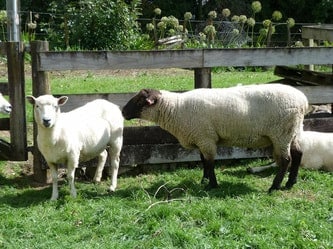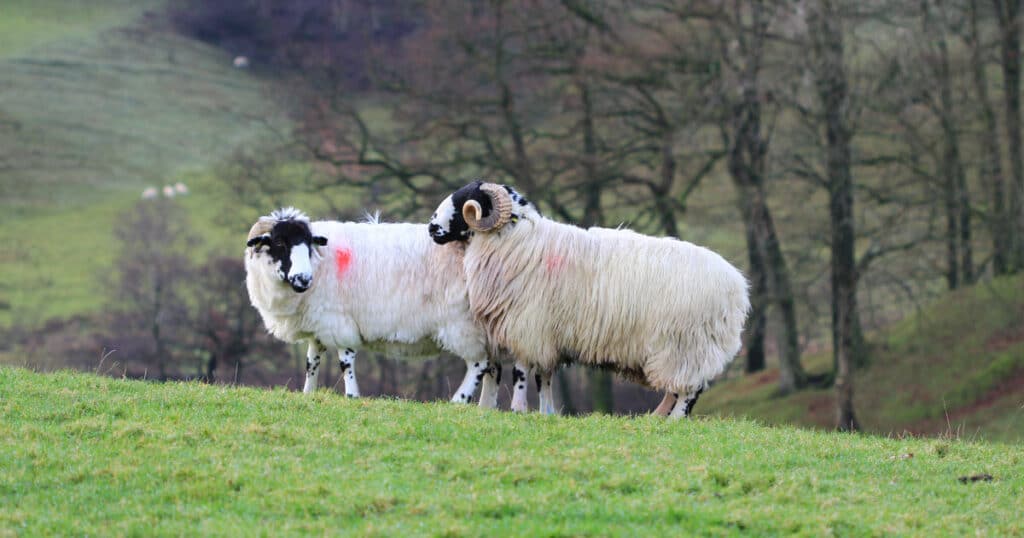In this article I’ll discuss the basics of sheep reproduction, including information and tips for successfully breeding sheep. Learn about the physiology of this species and sheep mating habits and management best practices.
While there are a handful of sheep breeds which are able to conceive year-round, the majority of sheep breed in the fall and winter. The shorter the days are the higher conception rates are for ewes – during the peak of summer many ewes do not have an estrus cycle at all.
Sheep Reproduction Basics
Let’s begin by covering the basics of sheep breeding and reproductive behavior. I’ll break this up by gender, starting with …
Ewe Fertility & Reproduction
Ewe lambs are typically 6 months when they have their first heat cycle and an estrus cycle typically lasts 17 days. Standing heat (when the ewe can conceive) lasting approximately 30 hours. Gestation (the time period from conception to delivery of the lambs) will vary slightly by breed, by ewe and by the number of lambs a ewe is carrying, but typically will be approximately 148 days.
In general, white-faced sheep breeds are considered “ewe breeds” and are noted for their strong maternal instinct and for being prolific. This isn’t to say that sheep breeds like the Hampshire or Suffolk can’t be good mothers, but in commercial operations many shepherds develop a crossbred ewe flock which are primarily Dorset (a breed known for being able to conceive lambs at any time of year) and develop more vigorous lambs by using terminal sires – Suffolk or Texel rams which are known to produce lambs with high-grade carcasses and a rapid growth rate.
Ram Fertility & Reproductive Behavior

Prior to turning a ram out to pasture with a flock of ewes for breeding season it’s important to evaluate his health and conditioning. Depending upon the size of your flock and how many ewes you expect him to breed your ram can run himself ragged chasing the ewes, losing a great deal of weight in the process. It’s important to be sure that your ram has sound hooves, good conditioning and it’s advisable to turn your ram in with your ewes during a cooler period of the day to avoid heatstroke.
If you have a large number of ewes (50 or more) and one ram is responsible for breeding them all during the dog days of summer you may consider turning the ram in with the ewes in the late afternoon and pulling him from the flock to a separate, shady pen during the heat of the day so he has time to rest and recover.
Using a Marking Harness When Breeding Sheep
A marking harness is a great tool for shepherds. This harness should be fitted snugly to your ram and a colored crayon is attached under his chest. This way when your ram has mounted and bread one of your ewes he leaves a temporary but clearly visible mark on her back. Those with a smaller flock should write this date down so they have a good idea of when that ewe will lamb based on the average gestation period (148 days). It’s recommended that you chain your ram’s chalk color every 15 days or so – this will allow you to monitor to see if he is re-marking your ewes. If he is there may be a problem with your ram’s fertility (your ewe didn’t conceive the first time around), so you may consider turning a “clean up” ram in with your flock later that fall to make sure that all of your ewes deliver lambs in the spring.
Flushing Your Ewes Prior to Mating Season
It has been proven that “flushing your ewes” (increasing the amount and quality of nutrition that they receive prior to breeding) can have an impact on the number of lambs they deliver. Higher nutrition can cause ewes to drop more eggs and since twins are desirable (there’s a lower risk of delivery complications associated with large single lambs and a lower chance of your ewe developing mastitis as each of her teats will have a regular visitor), it’s wise to begin feeding your ewes grain about two weeks prior to turning the ram out with them.

